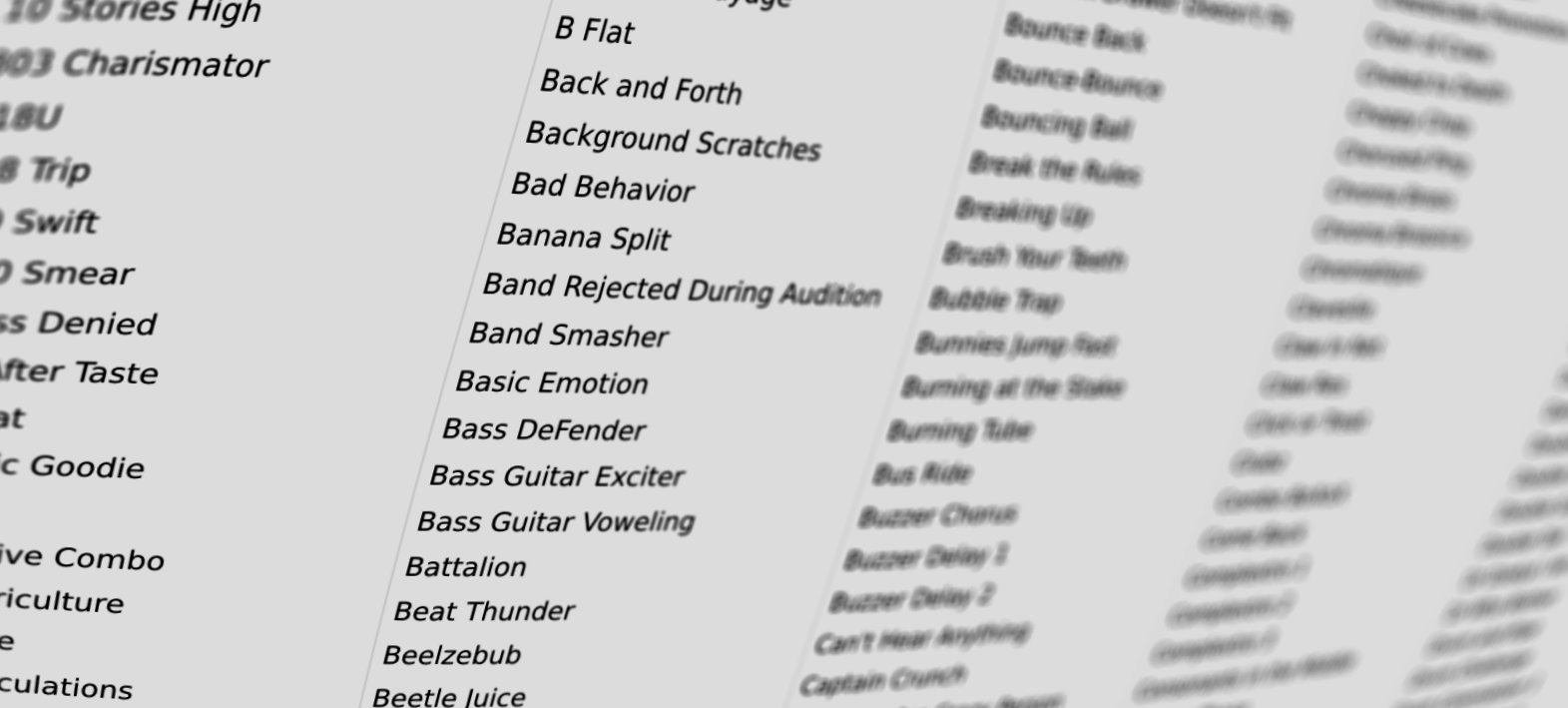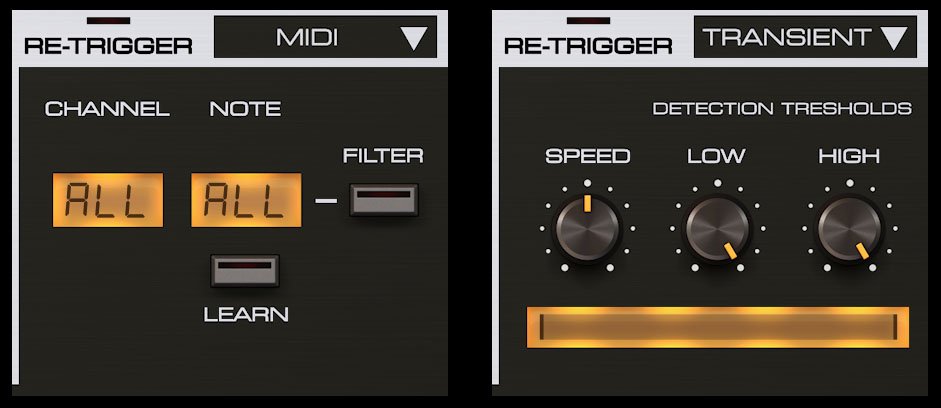Products
Instruments
Effects
Sound expansions
Bundles
Samples


Four independent delay lines
Four beefed-up delay units in one box to expand your sound-shaping capabilities beyond imagination.
High-quality delay line algorithm
Precisely adjust delay times across a wide range for a very flexible sound. Delay, chorus, flanger? You name it!
Multipurpose modulators
Four multipurpose modulators make it quick and easy to apply different types of modulation to several delay line parameters at the same time. This lets you do everything from adding subtle movement to your sound, to wild expressive delay effects.
Flexible signal routing
The four delay lines can easily be arranged in nine different ways, changing the signal flow between them and bringing unique delay sounds to your project
Get under the hood
Sigmund is far from just another delay. It provides an incredible degree of soundshaping freedom.
The plug-in consists of four discrete delay units, each with an independent set of parameters that offer you the freedom to shape your sound. There’s an ancient saying, often attributed to Aristotle: The whole is greater than the sum of its parts. With Sigmund, this is especially true as each of the delay lines has complementary modules such as filter and overdrive built in, working independently from the feedback loop. The delay lines themselves can also be combined together in several ways. Sigmund’s user interface has been designed from the ground up to be as intuitive as possible. Everything is presented as if on a silver (or brushed aluminum) platter, cleanly and clearly laid out with instant access to each section and its parameters.
Multimode filter
A very musical filter can work either inside or outside the feedback loop. Use it outside
to remove unwanted frequencies, or inside to create the impression of a fading sound.
You can even get creative by using it in a few lines at once to make any
filter effect you desire, such as wah-wah, vowel or even phaser sweeps.
Overdrive
Overdrive offers a whole variety of possibilities to shape your sound. With four delay lines at your disposal, you can go into the weeds pretty deeply and achieve complex multi-band distortion or multi-band dynamics effects.
Modulation amounts
You're in control of just how much the modulators affect filter cutoff, in-loop
delay time and/or volume of a delay line.
This makes it possible to get all sorts of modulation effects, ranging from choruses and flangers
(by affecting delay time) through to phasers, wah-wah (modulating cutoff parameter),
tremolo and panners (influencing volume).
In skilled hands, this feature becomes a powerful weapon.
Routing
Sigmund’s four delay lines can be interconnected with each other in nine
different routing topologies which give access to completely new dimensions of sound creation.
Say you have delays currently running in parallel, but would like to have a cascade of
serially connected delays instead: you can reconfigure them instantly with just a
click of the mouse.

Delay line mixer
For even greater convenience, the output signals of each delay line are combined in a purpose-built internal mixer to ensure more efficient workflow.
High quality delay line
The sound quality is so high, that it's possible to work
with even the smallest delay times with zero artifacts emerging, even down to one-tenth of
a millisecond.
So, it's possible without any tricks or half-measures to use a single
delay line not only as a traditional delay / echo effect, but also as a chorus
or flanger using smaller delay times.
Such precise control allows subtle modulation on time
parameters to delicately bring a sound to life and add gently flowing,
modulated warmth that is reminiscent of the analog delays of yesteryear.
Stereo options
The available stereo options expand Sigmund’s functionality to add a spatializer effect. Applying delays in different stereo modes (M/S or L/R) and adding phase shifts between channels can really widen things up.
A multitude of purposes
Sigmund can be effortlessly applied in nearly any configuration in the studio. It can be used as an insert effect for an instrument or bus channel, or as a versatile send effect with the help of a parameter lock that allows for auditioning presets without having to readjust the FX fader with each new selection.
Multi-purpose modulators
Four general-purpose modulators which can auto-modulate some of the delay lines' internal parameters. Each modulator can operate in three different modes:
- LFO - At extreme settings, the LFO is capable of twisting the input signal utterly beyond recognition and into what you might expect transmissions from an alien civilization to sound like!
- Envelope - In combination with a built-in transient detector, this gives you a very powerful tool; when applied to amplitude, you can freely shape your sound’s dynamics to control how it blends into the whole mix.
- Peak follower - It’s a must-have for a modulator; nothing else offers such an expressive wah-wah effect when applied to filter cutoff.


Multimode filter
A very musical filter can work either inside or outside the feedback loop. Use it outside
to remove unwanted frequencies, or inside to create the impression of a fading sound.
You can even get creative by using it in a few lines at once to make any
filter effect you desire, such as wah-wah, vowel or even phaser sweeps.
Overdrive
Overdrive offers a whole variety of possibilities to shape your sound. With four delay lines at your disposal, you can go into the weeds pretty deeply and achieve complex multi-band distortion or multi-band dynamics effects.
Modulation amounts
You're in control of just how much the modulators affect filter cutoff, in-loop
delay time and/or volume of a delay line.
This makes it possible to get all sorts of modulation effects, ranging from choruses and flangers
(by affecting delay time) through to phasers, wah-wah (modulating cutoff parameter),
tremolo and panners (influencing volume).
In skilled hands, this feature becomes a powerful weapon.
Over 400 neatly arranged presets
A convenient preset browser allows quick auditioning of the vast factory library.
In combination with the padlocks system for locking individual parameters when changing presets, this allows you to zero in on the desired effect with extreme efficiency.

Routing
Sigmund’s four delay lines can be interconnected with each other in nine
different routing topologies which give access to completely new dimensions of sound creation.
Say you have delays currently running in parallel, but would like to have a cascade of
serially connected delays instead: you can reconfigure them instantly with just a
click of the mouse.

Delay line mixer
For even greater convenience, the output signals of each delay line are combined in a purpose-built internal mixer to ensure more efficient workflow.
High quality delay line
The sound quality is so high, that it's possible to work
with even the smallest delay times with zero artifacts emerging, even down to one-tenth of
a millisecond.
So, it's possible without any tricks or half-measures to use a single
delay line not only as a traditional delay / echo effect, but also as a chorus
or flanger using smaller delay times.
Such precise control allows subtle modulation on time
parameters to delicately bring a sound to life and add gently flowing,
modulated warmth that is reminiscent of the analog delays of yesteryear.
Four delay lines
You have 4 independent delay lines to your disposal that can be interconnected in 9 different
ways / topologies, using the routing display.
Every line equipped with its own set of parameters and modules like filter, overdrive
and modulation amounts for total creative freedom.

Stereo options
The available stereo options expand Sigmund’s functionality to add a spatializer effect. Applying delays in different stereo modes (M/S or L/R) and adding phase shifts between channels can really widen things up.
A multitude of purposes
Sigmund can be effortlessly applied in nearly any configuration in the studio. It can be used as an insert effect for an instrument or bus channel, or as a versatile send effect with the help of a parameter lock that allows for auditioning presets without having to readjust the FX fader with each new selection.
Multi-purpose modulators
Four general-purpose modulators which can auto-modulate some of the delay lines' internal parameters. Each modulator can operate in three different modes:
- LFO - At extreme settings, the LFO is capable of twisting the input signal utterly beyond recognition and into what you might expect transmissions from an alien civilization to sound like!
- Envelope - In combination with a built-in transient detector, this gives you a very powerful tool; when applied to amplitude, you can freely shape your sound’s dynamics to control how it blends into the whole mix.
- Peak follower - It’s a must-have for a modulator; nothing else offers such an expressive wah-wah effect when applied to filter cutoff.

Modulator re-triggering
Each modulator can be independently re-triggered with MIDI notes or the signal itself (with a transient detector) when LFO or ENV modulator type is selected, allowing for yet more control and creative freedom.

Substantial factory content
Over 400 presets and patterns in factory content
Screen fit
Several UI sizes and HiDPI support for better screen fit
MIDI Learn
MIDI Learn for easy controller assignment
Downloads
Manuals
User Manual - English versionSystem requirements
Windows PC
- OS version
- Windows 7 or newer
- CPU
- Intel x86 / AMD x86
- Software
- VST2 / VST3 / AAX compatible host application (64bit only!)
- Sample rate
- ≥ 44.1 kHz
Apple Mac
- OS version
- Mac OS X 10.13 to macOS 15
- CPU
- Intel x86 / Apple Silicon
- Software
- VST2 / VST3 / AU / AAX compatible host application (64bit only!)
- Sample rate
- ≥ 44.1 kHz
Document containing system requirements for entire D16 Group plug-in line-up you can download from here Compatibility Chart
Note
This product is not a standalone program so you need a host application to use it.














